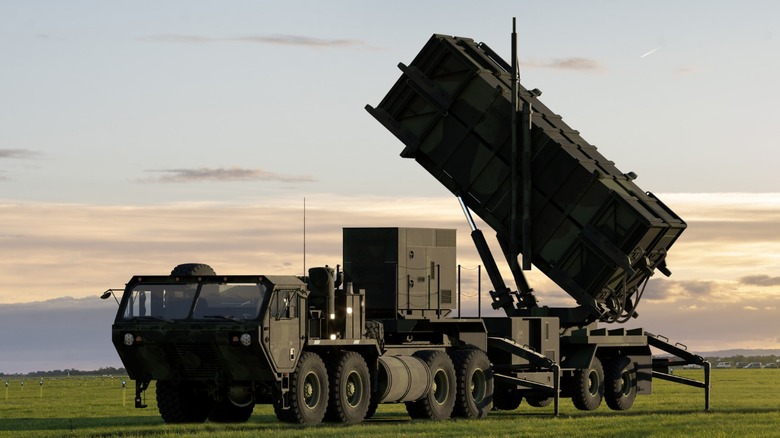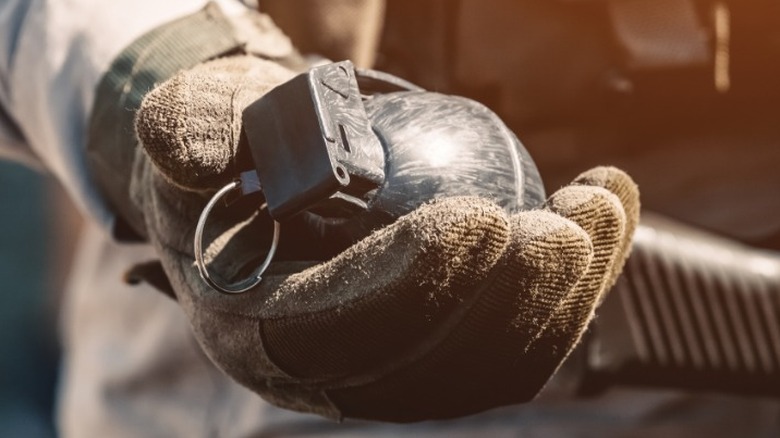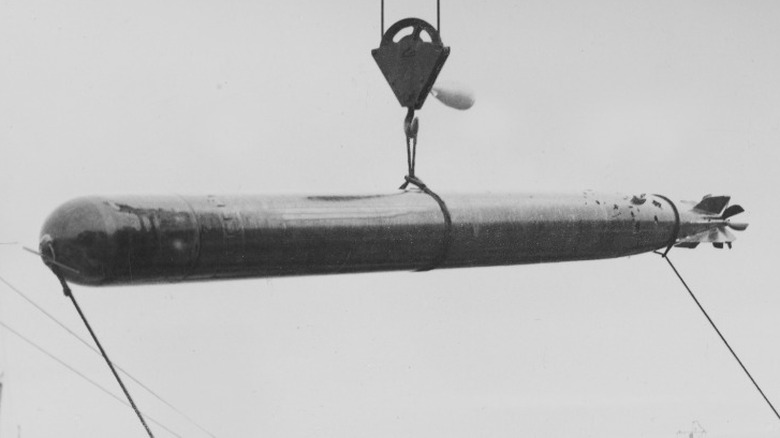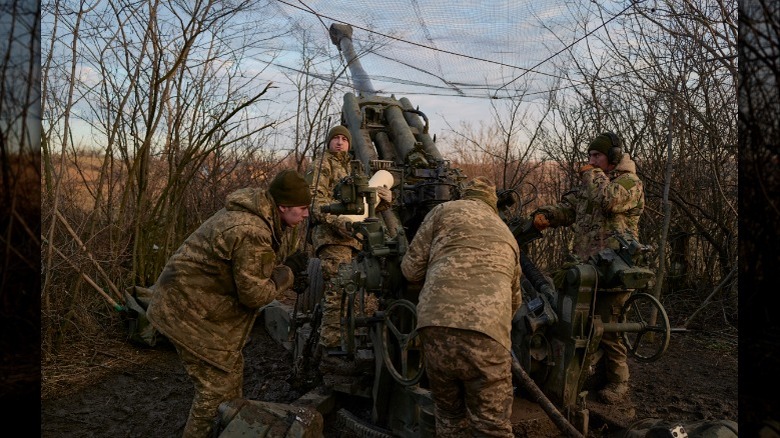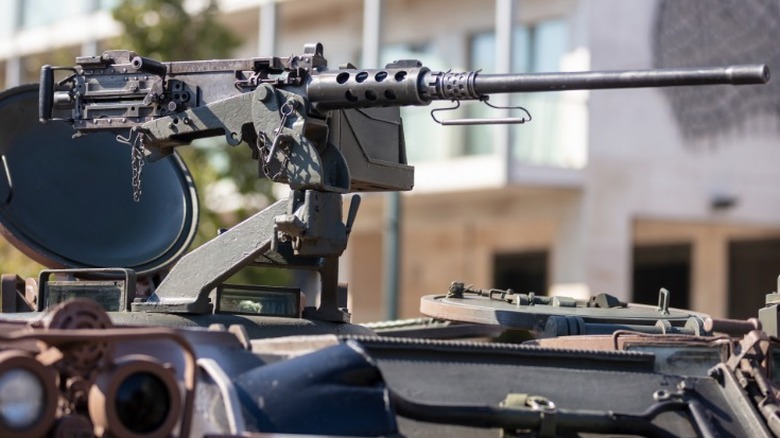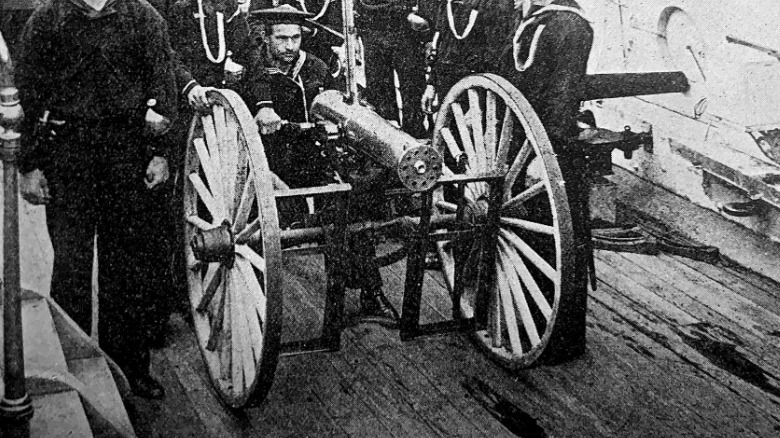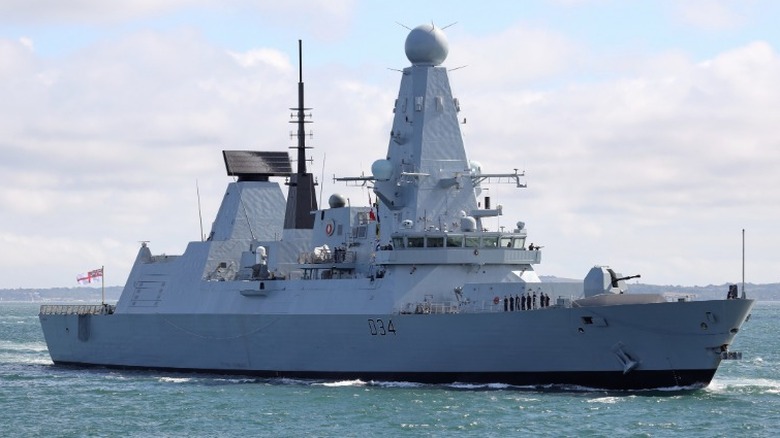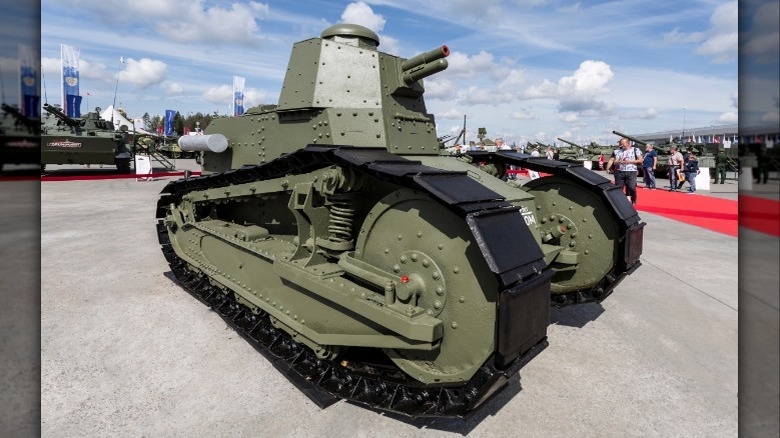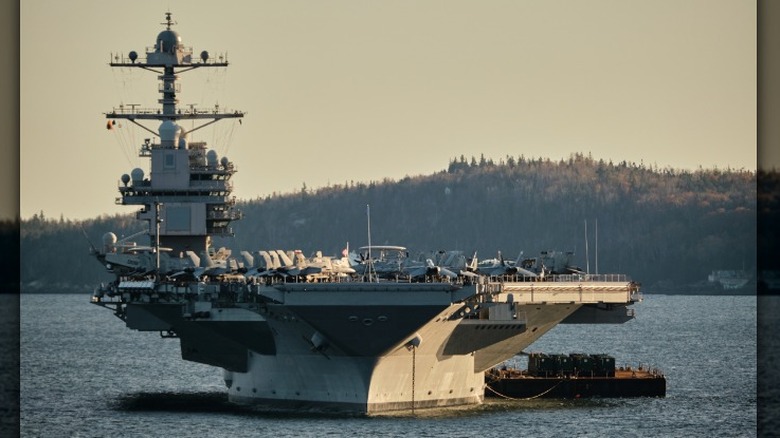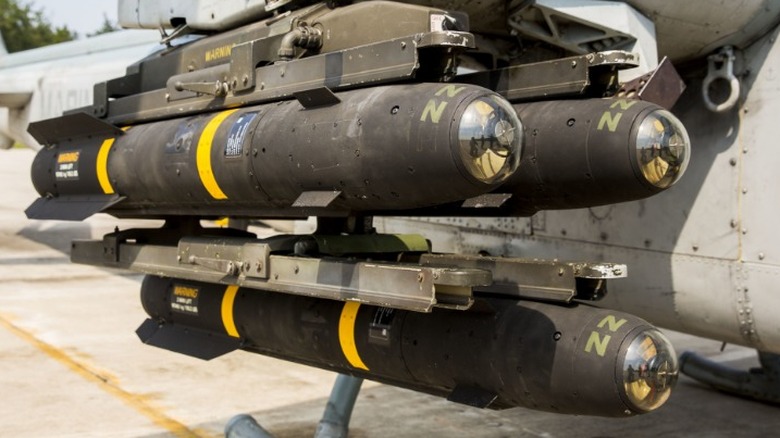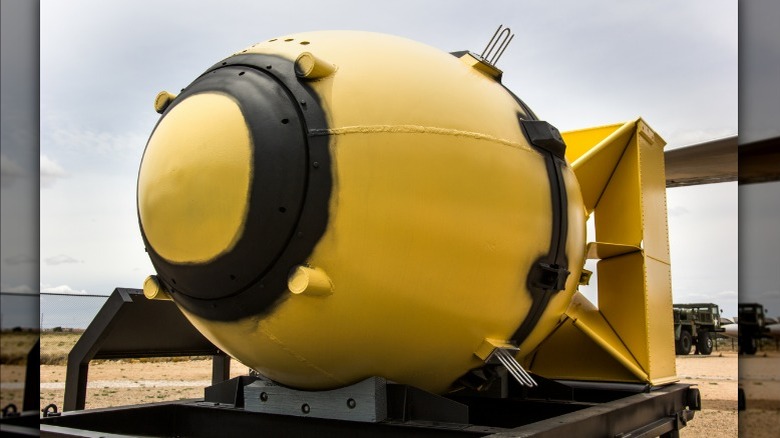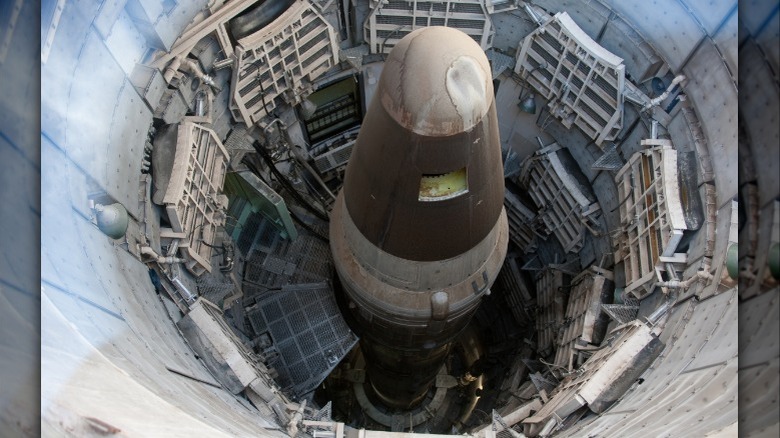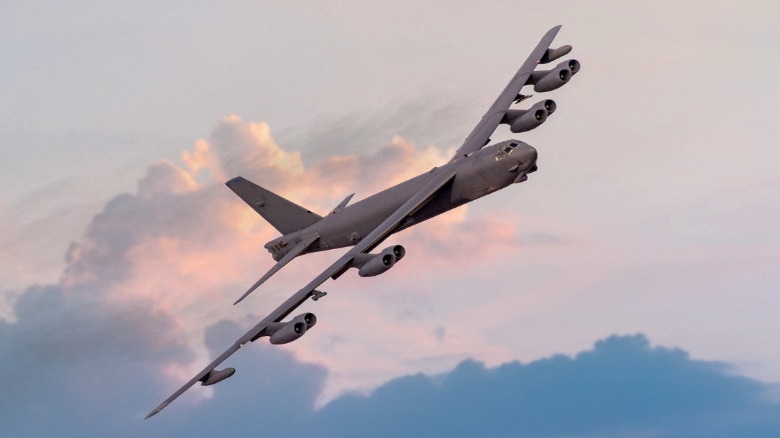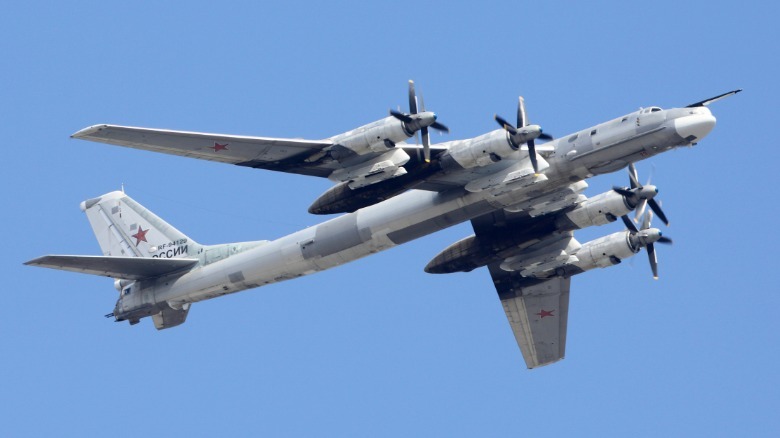The Most Dangerous Military Weapons Ranked By Length Of Service
War is a phenomenon as old as humankind itself. The weapons of war have developed and become more advanced over time, but the purpose has remained the same — to exert dominance over an adversary. The industrial revolution and the advent of mechanized warfare have had the greatest impacts on weaponry and it is during these periods that many of our modern weapons came to be.
While the ancient weapons of swords and spears are very dangerous in close combat, and other early weapons such as Greek Fire are equally alarming in a battle, only in the past few hundred years since the invention of guns and cannons have the true terror of war weapons been realized. The industrial revolution gave rise to increasingly lethal military weapons, but it was the mechanized warfare of World War I that signaled a dramatic change in the execution of warfare in a manner that would cause mass devastation to all the people and lands in affected areas of conflict. It is important to study these powerful tools of destruction without glorifying them as they continue to be integral to our modern existence. Therefore, these are 11 of the most dangerous military weapons ranked by longevity.
Hand grenade
The roots of the modern hand grenade can be traced back to the 17th century when French forces under King Francis I made grenades using glass globes, jars, firepots, and kegs. Several thousand grenades were used during the Crimean war in the 1850s, but it was not until the Russo-Japanese war at the turn of the 20th century that the grenade became a weapon widely used across all regiments.
The grenade has ever since been a part of a modern soldier's kit and are crucial tactical weapons to be used in urban warfare. A modern grenade consists of a shell designed to break apart into shrapnel filled with an explosive and a time-delayed fuse. They are manufactured in a variety of styles utilizing varying materials and explosives and are produced by military production facilities around the world as grenades are simple and low-tech weapons. The impact of grenades is limited by their relatively small size, but, when used effectively, they can clear a position when fighting in close quarters, especially when going into situations with little to no advanced visual contact with the enemy.
In modern times, grenades have also been adapted to be shot from a distance with weapons such as the rocket-propelled grenade launcher and even more recently, Ukrainians have adapted grenades to be successfully dropped on enemy positions from drones.
Torpedo
The development of the torpedo, a gunpowder-packed device meant to travel in water toward naval targets, began in the early 1800s and likely the first conflict to see them used was the Crimean War. Many of the most lethal weapons still used today were only possible with the industrial revolution and the Crimean War occurred right in the middle of this period. The earliest weapons called torpedoes, which were deployed during the American Revolutionary War, were more akin to what we would call mines today, as they were kegs filled with gunpowder and a trigger to initiate an explosion on contact. The Imperial Russian Navy used these on a large scale during the Crimean War to destroy British ships but only managed to damage some of them.
Torpedoes have since evolved into highly sophisticated devices capable of inflicting immense damage upon targets. Early applications employed piston engines run on compressed air and were later configured to use various chemicals as fuels, while other versions developed after World War II used electric motors. Modern torpedoes are packed with electronics and computers for guidance controls that make them accurate and efficient naval weapons packed with a significant payload of explosives. They are also surprisingly difficult to intercept when launched from submarines, which is among the reasons they are still deployed in fleets to this day.
Howitzer
The Howitzer is an artillery piece that was originally developed as a smaller and more mobile version of the cannons that were prevalent in the early part of the 19th century, but with a similar range. The first American Howitzer development began in the 1830s and resulted in the Model 1841 Mountain Howitzer. Unlike cannons that previously existed and remained stationary at forts or on ships, the Howitzer was much smaller and mounted on a frame with wheels, allowing it to be hauled with horses, and this made it especially important for use as the country expanded westward.
Although they have grown and become more sophisticated, Howitzers are still a part of the modern battlefield. They are pulled by horsepower instead of horses and the accuracy is assured by precision instruments. Weighing less than 10,000 pounds and firing 155mm ammunition, the American M777 Howitzer is extremely easy to move and maneuver, which is imperative to prevent being targeted by opposing forces. When up against something such as the Russian 2S7 Pion, a 93,000-pound self-propelled cannon that uses 203mm ammunition, the lighter M777 can be highly effective.
Machine gun
The American Civil War saw the first use of what could be considered the predecessor to the modern machine gun. With the turn of a crank, the Gatling could send a hail of bullets being fired in rapid succession toward the enemy. The Gatling received a patent in 1862 and gave Union troops the ability to fire 200 rounds per minute from a single gun, an unheard-of feat at the time. Later, in 1884, the first fully automatic machine gun was born, the Maxim gun. While the Gatling required a continuous crank for rapid fire, the Maxim gun used the natural recoil to eject shells and fire another one, negating the need for additional barrels or a cranking mechanism. This would change infantry forever, especially with the outbreak of WWI.
Machine guns are today an important part of an infantryman's kit. Most soldiers are equipped with a handheld automatic rifle, but a larger variant used by the U.S. Army is among the oldest of all equipment still in service, the M2 heavy machine gun. Developed by John Moses Browning in 1918 during WWI, the M2 has gone on to be in service for more than a century. It is a powerful .50 caliber rifle that has a range of more than 1,000 yards and can shoot around 500 rounds per minute. It has proven to be so reliable and robust, the Pentagon has had no need to replace it.
Navy destroyer
A modern navy uses fleets of various types of boats and other water vessels to ensure its national security. Among the most powerful vessels in any fleet are the destroyers. As shipbuilders began to changeover from wooden sailing ships to steam engine-powered ships of iron, naval commanders ordered the procurement of new boats for military service. In 1899, the U.S. Navy ordered 16 boats that would become the first American destroyers. These would be an average of 250 feet in length with coal-fired boilers and armed with multiple torpedo tubes, 50 caliber rapid-fire guns, and 6-pounder cannons. The reciprocating steam engines produced around 8,000 horsepower good for up to 30 knots of cruising speed. These would serve the U.S. through WWI and be replaced soon after.
Through the following decades, destroyers would continue to be the most powerful of weapons deployed by any navy, and the destroyers of the U.S. Navy were instrumental in the fight against the Japanese during WWII. Today's destroyers carry an impressive arsenal with huge potential for mass destruction. They are powered by huge gas turbine propulsion systems and armament includes Mk 45 5-inch caliber automatic guns, multiple torpedo tubes, Tomahawk missiles, and evolved Sea Sparrow missiles. Further surveillance capabilities include advanced radar systems with satellite communications and onboard helicopters. These ships are massive displays of power that sail around the world ready to deal with threats at a moment's notice.
Tanks
The horrors of trench warfare and the introduction of mechanized infantry led to a great deal of rapid innovation in military hardware during WWI. Trenches along the front in Eastern France appeared almost immediately as the fighting intensified, and military engineers needed to figure out how to overcome these defenses. The British were the first to develop a new machine that would be a huge lumbering hunk of steel and tracks that would become known as the tank.
The first feasible design produced in large numbers was the British MK IV. It was called a tank in internal documents to hide its true nature should enemy spies get a hold of the information, thinking nothing but water tanks were being requisitioned for the front. The impact of the tanks proved to be immense, and as crude as they were, the MK IV tanks helped the Allied powers turn the tide toward victory. The Renault FT was also deployed, being the first light tank on the battlefield with a crew of three compared to the MK IV crew of eight.
The tank has since become one of the defining features of a modern battlefield and has been deployed in conflicts around the world between rival armies of nations big and small. Modern tanks are full of electronic surveillance and targeting equipment and use advanced metallurgy to create highly protective hulls. The American M1 Abrams, German Leopard, and British Challenger are among the most advanced and capable tanks in production and appear set to be part of fighting forces for the foreseeable future.
Aircraft carrier
Aircraft carriers serve as the ultimate display of naval power today, but the history of launching and landing planes from vessels at sea stretches back for more than a century. Airplanes proved their mettle during WWI, and they were seen as key parts of defense in the post-war period. In this period, the U.S. and Japan began building vast warships equipped with runways on the deck, giving them the ability to bring air power with them to faraway places. Japan would use this strength for imperial domination while America would eventually use it to stop Japan.
The first aircraft carriers were modified naval destroyers with a flight deck built atop the existing ships until the U.S.S. Ranger was built as the first clean sheet carrier design in 1934. These vessels have since evolved into floating cities with crews in the thousands carrying dozens of aircraft and powered by nuclear energy. The newest carrier in the American fleet is the U.S.S. Gerald R. Ford, commissioned in 2017. It features two nuclear reactors and is manned by a crew of around 5,500 who maintain and fly more than 75 aircraft. It is more than 1,000 feet long and is the most advanced ship of its type in the world, and any adversary would do well to think twice before attempting to challenge its fleet of F-35 and F-22 Raptors as well as its many guns and missiles onboard.
Cruise missiles
Rocket technology to create firebombs capable of flying toward a target and destroying it has been under development as far back as the 13th century in China with gunpowder-fueled rockets. The concept and execution of a design for a self-powered and guided cruise missile originated with the Nazis during WWII. The first of these was the V-1, often called a "Buzz Bomb" by the British who were the targets. It carried a one-ton warhead and could fly 150 miles, but with very low accuracy.
Modern cruise missiles vary in design, size, and capability. They are self-powered and fly at subsonic speeds, usually on a direct trajectory toward the target. This makes them useful as air defense weapons or as offensive air-to-air weapons for use in aerial combat. Current American arsenals include its Hellfire, with a range of 7-11 km, and the Tomahawk, which can hit targets of up to 2,500 km in distance. Furthermore, electronic guidance systems and advanced flight controls on the missiles themselves make modern cruise missiles extremely accurate and they are capable of carrying devastating payloads.
Nuclear warheads
The results of the Manhattan Project unleashed a deadly force with unimaginable capabilities that were laid bare to the world when two weapons were dropped on Nagasaki and Hiroshima to end WWII. To our great fortune, these weapons have not again been deployed at any time since the cessation of hostilities of WWII. However, the potential to wipe out civilization as we know it remains a constant threat and looks to remain a threat for generations to come.
The possibility of a nuclear weapon begins with Marie Curie's experiments with radioactive material and the breakthroughs in science following. But it was in 1933 that a Hungarian physicist hypothesized that a nuclear chain reaction could be used to harness and use the energy produced. His ideas led to research being done by German scientists a few years later coming to the realization that a nuclear weapon was possible and that Nazi scientists could be working on one. They thought the Germans could be using Albert Einstein's E = mc² equation for their research and alerted Einstein himself, and he, knowing the danger this represented, wrote to President Roosevelt to warn him of what was happening. This sowed the seeds of what would become the Manhattan Project that created the Fat Man and Little Boy bombs that detonated over Japan in 1945.
In the decades since WWII, many countries have developed nuclear weapons and amassed stockpiles of warheads capable of mass destruction multiple times the scale of the attacks in 1945. The Cold War saw rapid development of nuclear capabilities with testing being conducted in the atmosphere, water, and underground, but subsequent treaties have brought all of that nearly to a close, with North Korea being a particular exception.
Intercontinental ballistic missiles
Ballistic missiles are different from cruise missiles in that they travel along a ballistic path that uses an upward trajectory and follows an arc, traveling back down to Earth after passing the apex. The intercontinental ballistic missile (ICBM) is one of the most dangerous of all weapons as it can carry nuclear warheads thousands of miles to its target. Research into ballistic missiles was also originally undertaken by the Nazis as they developed the V-2 rocket, the successor to its V-1 cruise missile.
With the confiscated research the Allies had removed from Germany after WWII, work began in earnest on further developing rockets that could deliver payloads over vast distances. The first of these tests in the U.S. happened in 1948, and the Atlas program was given express authority in 1954 to produce an intercontinental missile that could deliver a thermonuclear warhead across the ocean. The first Atlas ICBM was put into service in 1959.
Today, the Department of Defense states that it has an arsenal of 400 Minuteman III missiles deployed as part of America's nuclear triad, which consists of nuclear capabilities from land, sea, and air. These weapons are maintained as a deterrent in the hopes they will prevent any future adversary from attacking the United States with a full-scale attack. It is hoped by all that they will never need to be used.
B-52 Stratofortress
This example differs in that it is a specific model rather than a broad category of weapons, but it is so remarkable that it deserves its own mention. Following WWII, the U.S. Air Force needed to upgrade its bombers from the B-29 Superfortress that valiantly fought and defeated the Axis Powers. An upgraded bomber was needed after the war, and that need would eventually deliver the B-52 Stratofortress long-range bomber.
The B-52 is an extraordinary aircraft equipped with eight turbofans — it was originally equipped with turbojets — that was first flown in 1952 for testing and delivered to the Air Force for service by 1955. It was developed as an aircraft that could deliver nuclear weapons to targets thousands of miles away, and its range of 8,800 miles at an altitude of 50,000 feet, but can also be refueled in-flight. Its payload capacity is 70,000 pounds and can carry a combination of bombs and missiles and is equipped with four .50 caliber machine guns. The B-52 has served over the skies of almost every conflict in which the U.S. Air Force has been involved and has also received many updates over the years, including sophisticated avionics, surveillance, and communications equipment.
With the latest updates, the B-52 is expected to continue in service for many more years, meaning there is a possibility it could be flying on its 100th anniversary of service. While the Soviet Tupolev Tu-95 may have been put into service a few years earlier, the B-52 still beats it where it counts by being the superior aircraft with the best technology and firepower.
